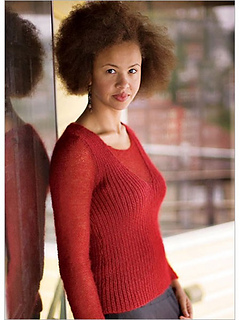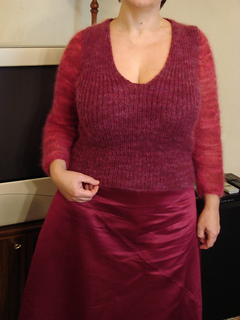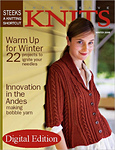patterns > Interweave Knits >  Interweave Knits, Winter 2006 and 1 more...
Interweave Knits, Winter 2006 and 1 more...
> Cabernet Ribs








Cabernet Ribs
Interweave SKU: EP0937
Pattern description from Interweave Knits, Winter 2006:
Liz Nields uses a two-strands-to-one-strand technique to create faux layers in her handsome pullover. The ribbed vest-like body is worked in a strand of merino held together with a silk/mohair yarn. The sleeves and neckline are knitted from a single strand of mohair to make a sheer ‘under-layer.’ A single piece, this sweater will take you well beyond the holiday season.
Finished Size: 34 (38½, 41½, 46, 50, 54½)“ bust circumference, slightly stretched.
Yarn: Filatura Di Crosa Zara (100% merino; 137 yd [125 m]/50 g): #1493 red (A), 5 (5, 6, 7, 7, 8) balls. Filatura Di Crosa Baby Kid Extra (80% kid mohair, 20% nylon; 268 yd 245 m/25 g): #479 red (B), 4 (4, 4, 5, 6, 6) balls. Yarns distributed by Tahki Stacy Charles.
Yarn Weight: #3 - Light
Needles: Size 7 (4.5 mm). Adjust needle size if necessary to obtain the correct gauge.
Notions: Size F/5 (3.75 mm) crochet hook; markers (m); tapestry needle.
Additional Gauge:
- 26 sts and 26 rows = 4” in k1, p1 rib with A and B held tog, unstretched
- 18 sts and 28 rows = 4” in garter st with B
Originally Published: Interweave Knits, Winter 2006
Notes from Interweave Knits, Winter 2006:
- “When measuring each piece, slightly stretch it widthwise so that the ‘slightly stretched’ gauge is achieved.”
- “When working the second and third bind-offs, slip the first stitch to be bound off, then continue normally. This will give you a smoother edge.”
- “When working with mohair, it is important to use a ‘light hand’ to prevent the yarn from becoming too tight on the needle, and to keep the cast-on and bind-off edges loose.”
974 projects
stashed
1140 times
11088 projects
stashed
8103 times
- First published: November 2006
- Page created: June 4, 2007
- Last updated: October 14, 2020 …
- visits in the last 24 hours
- visitors right now





